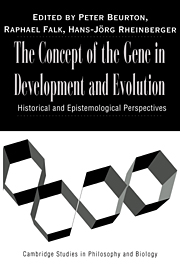Book contents
- Frontmatter
- Contents
- Introduction
- List of Authors
- PART ONE GENES AND TRAITS
- 1 The Dissolution of Protein Coding Genes in Molecular Biology
- 2 The Differential Concept of the Gene: Past and Present
- 3 Gene Concepts and Genetic Concepts
- PART TWO EXTRACTING THE UNITS OF HEREDITY
- PART THREE GENETIC PROGRAMS AND DEVELOPMENTAL GENES
- PART FOUR CONCEPTUAL PERSPECTIVES
- FINAL REVIEW
- Glossary
- Index
2 - The Differential Concept of the Gene: Past and Present
from PART ONE - GENES AND TRAITS
Published online by Cambridge University Press: 12 January 2010
- Frontmatter
- Contents
- Introduction
- List of Authors
- PART ONE GENES AND TRAITS
- 1 The Dissolution of Protein Coding Genes in Molecular Biology
- 2 The Differential Concept of the Gene: Past and Present
- 3 Gene Concepts and Genetic Concepts
- PART TWO EXTRACTING THE UNITS OF HEREDITY
- PART THREE GENETIC PROGRAMS AND DEVELOPMENTAL GENES
- PART FOUR CONCEPTUAL PERSPECTIVES
- FINAL REVIEW
- Glossary
- Index
Summary
ABSTRACT
The differential concept of the gene was created by geneticists at the beginning of the twentieth century to fill the need for a workable research method given the newly established formal theory that claimed many-to-many relationships between genes and traits. This concept can be reconciled with both one-to-one and many-to-many relationships between genes and traits because it deals with a different ontological level: the relationships between changes in genes and changes in traits, rather than the nature of the entities themselves. This flexible nature may also allow the term gene to survive its replacement by the term genome. The differential concept of the gene, except for its predicate, is not specific to genetics. The concept is fundamental, though to some degree intuitive, hence exhibiting power and weakness. Also, it is used continuously in studies of connections between the genotypic and phenotypic levels. In contrast to classical transmission genetics, where the interest in the relations between mutations and alternative appearances of traits is derived mainly from the need for a research method, the present interest is twofold: a research method and a research subject. The present use of the differential concept of the gene is characterized by its refinement: Different alternative states of a gene are to be related to different alternative appearances of a trait. This requires resolution capability at both the genotypic and phenotypic levels and is guided by the reductionist assumption that at least some mutations make a difference in the phenotype.
- Type
- Chapter
- Information
- The Concept of the Gene in Development and EvolutionHistorical and Epistemological Perspectives, pp. 26 - 39Publisher: Cambridge University PressPrint publication year: 2000
- 17
- Cited by



